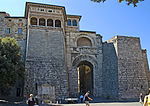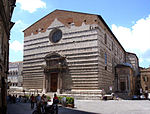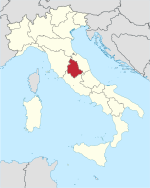Università per Stranieri di Perugia
1921 establishments in ItalyEducation in PerugiaEducation in UmbriaEducational institutions established in 1921Universities in Italy

The Università per Stranieri di Perugia is an Italian university oriented towards study by foreign students of Italian language and culture. It was established by royal decree in 1925, and is housed in the Palazzo Gallenga Stuart in Perugia, in Umbria in central Italy. In the academic year 2017–2018 it had a total of 944 undergraduate and 61 postgraduate students; of the undergraduates, approximately two thirds were women, and little more than one third were from outside Italy.
Excerpt from the Wikipedia article Università per Stranieri di Perugia (License: CC BY-SA 3.0, Authors, Images).Università per Stranieri di Perugia
Via del Maneggio, Perugia Sant'Erminio
Geographical coordinates (GPS) Address Nearby Places Show on map
Geographical coordinates (GPS)
| Latitude | Longitude |
|---|---|
| N 43.115 ° | E 12.389 ° |
Address
Via del Maneggio
Via del Maneggio
06122 Perugia, Sant'Erminio
Umbria, Italy
Open on Google Maps









